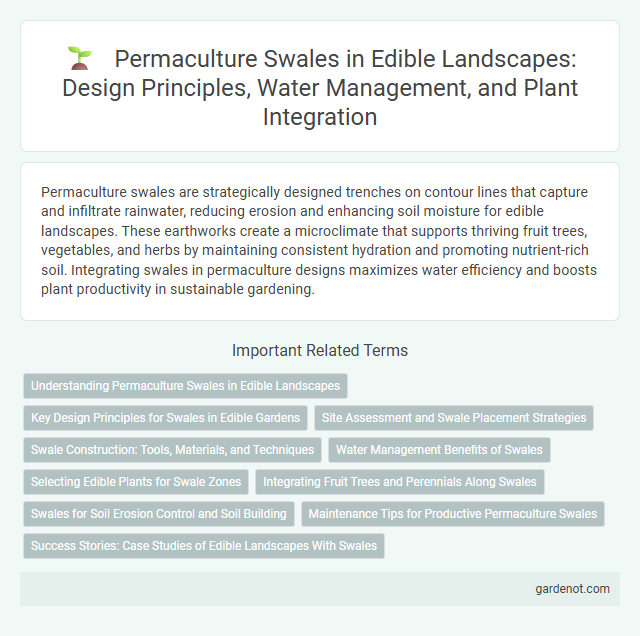Permaculture swales are strategically designed trenches on contour lines that capture and infiltrate rainwater, reducing erosion and enhancing soil moisture for edible landscapes. These earthworks create a microclimate that supports thriving fruit trees, vegetables, and herbs by maintaining consistent hydration and promoting nutrient-rich soil. Integrating swales in permaculture designs maximizes water efficiency and boosts plant productivity in sustainable gardening.
Understanding Permaculture Swales in Edible Landscapes
Permaculture swales are strategically designed landscape features that capture and store rainwater, promoting soil hydration and reducing erosion in edible landscapes. These shallow, contour-aligned ditches with berms enhance water retention, supporting the growth of fruit trees, vegetables, and herbs by creating microclimates and improving soil fertility. Implementing permaculture swales optimizes water efficiency, increases plant resilience, and contributes to sustainable, productive edible ecosystems.
Key Design Principles for Swales in Edible Gardens
Permaculture swales in edible gardens optimize water retention by capturing runoff and allowing gradual infiltration into the soil, supporting deep-rooted plants and improving soil health. Key design principles include contour alignment to follow natural land slopes, proper sizing based on catchment area and rainfall, and integration with companion planting to maximize nutrient cycling and biodiversity. Swales also reduce erosion and promote microclimate stability, enhancing overall garden productivity and resilience.
Site Assessment and Swale Placement Strategies
Site assessment for permaculture swales involves analyzing slope gradient, soil type, water flow patterns, and vegetation to determine optimal placement for water catchment and erosion control. Swale placement strategies prioritize positioning along contour lines to maximize water infiltration, enhance soil moisture retention, and support diverse plant growth in edible landscapes. Effective swale integration requires understanding site-specific hydrology and microclimates to improve garden productivity and sustainability.
Swale Construction: Tools, Materials, and Techniques
Swale construction in edible landscapes involves shaping contour-aligned trenches to capture and infiltrate water efficiently, using tools such as shovels, mattocks, and laser levels for precise excavation. Materials commonly include native soil, compost, mulch, and organic matter to enhance water retention and soil fertility. Techniques emphasize gentle slopes, berm placement downslope, and careful compaction to prevent erosion and promote sustainable moisture distribution for permaculture gardens.
Water Management Benefits of Swales
Permaculture swales optimize water management by capturing and infiltrating rainwater, reducing runoff and soil erosion. These earth-contoured ditches increase groundwater recharge and maintain soil moisture, promoting healthier edible landscapes. Their strategic placement enhances plant growth and resilience in permaculture systems by conserving vital water resources.
Selecting Edible Plants for Swale Zones
Selecting edible plants for permaculture swale zones involves prioritizing species that thrive in varying moisture gradients created by the swale's design. Moisture-loving plants such as mint, watercress, and berries should be placed in the lower, wetter zones, while drought-tolerant species like rosemary, sage, and olives suit the higher, drier edges. Integrating nitrogen-fixers like clover and dynamic accumulators like comfrey enhances soil fertility and supports a diverse, productive edible landscape.
Integrating Fruit Trees and Perennials Along Swales
Integrating fruit trees and perennials along permaculture swales enhances water retention and soil fertility by capturing runoff in keyline design patterns. Swales provide a microclimate that supports deep root systems, promoting efficient nutrient cycling and reducing erosion. Strategic placement of nitrogen-fixing perennials alongside diverse fruit tree species increases overall ecosystem resilience and boosts edible yield.
Swales for Soil Erosion Control and Soil Building
Permaculture swales are key landscape features designed to capture and slow water runoff, significantly reducing soil erosion on sloped terrain. By holding water, swales increase soil moisture infiltration, promoting deep root growth and enhancing soil microbial activity, which builds soil fertility over time. This method not only stabilizes slopes but also improves the long-term productivity and resilience of edible landscapes.
Maintenance Tips for Productive Permaculture Swales
Regular inspection and clearing of debris from permaculture swales prevent water flow obstruction and soil erosion, ensuring optimal moisture retention for edible landscapes. Mulching swale berms with organic materials like straw or wood chips promotes soil fertility, suppresses weeds, and supports beneficial microbial activity. Periodic pruning of nearby vegetation and regrading swale edges maintain efficient water distribution and prevent stagnation, enhancing productivity in permaculture systems.
Success Stories: Case Studies of Edible Landscapes With Swales
Permaculture swales have transformed edible landscapes by enhancing water retention and soil fertility, leading to robust plant growth as seen in case studies across diverse climates. For example, a permaculture farm in California reported a 40% increase in fruit yields after integrating swales, which efficiently capture rainwater and reduce erosion. Similarly, a community garden in Australia demonstrated improved food security and biodiversity through strategic swale placement, showcasing the technique's scalability and sustainability.
Permaculture swale Infographic

 gardenot.com
gardenot.com